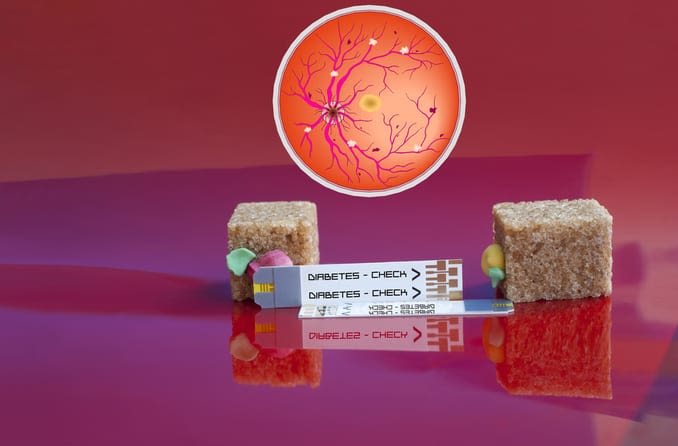Diabetic eye disease: What's your risk?

Diabetic eye disease refers to a group of eye conditions that can affect individuals who have diabetes. Specific eye diseases and conditions caused by diabetes include:
Diabetic macular edema
Glaucoma
Retinal detachment
Cataracts
Vitreous hemorrhage
While some of these conditions can also affect people who don’t have diabetes, the risk of development is much higher when diabetes is present.
Knowing what puts you at a higher risk of developing eye complications from diabetes can help you take steps toward prevention.
Risk factors
Risk factors for developing diabetic eye disease include:
How long you’ve had diabetes — the longer you’ve had it, the higher your risk
Untreated high blood glucose (hyperglycemia)
Untreated high blood pressure (hypertension)
Untreated high cholesterol
Smoking
Being African American, Hispanic or Native American
Age
According to the U.S. Centers for Disease Control and Prevention (CDC), diabetes is the leading cause of blindness among adults aged 18-64 years. Additionally, a person with diabetes is twice as likely to develop glaucoma or cataracts as someone without diabetes.
SEE RELATED: Latino Americans Are at a Higher Risk of Eye Disease
Diabetic retinopathy
The most common diabetic eye disease is diabetic retinopathy. The condition occurs after consistently high blood sugar levels damage blood vessels in the retina, the light-sensing tissue that lines the back of the eye.
In the first stage of diabetic retinopathy (called nonproliferative diabetic retinopathy), blood vessels can become blocked, cutting off blood supply to the retina.
In response, new, abnormal blood vessels begin to proliferate (develop) in the retina. Unfortunately, these abnormal vessels can leak and develop scar tissue, which can cause a retinal detachment. Vision loss and a number of other eye diseases also can occur without early and proper treatment. This more advanced stage is called proliferative diabetic retinopathy.
While diabetic retinopathy only affects individuals with type 1 or type 2 diabetes, it is possible for someone who does not have diabetes to experience retinopathy, another condition that results from damage to the retina.
Macular edema
Directly linked to diabetic retinopathy, macular edema is caused when fluid from abnormal blood vessels collects in the macula. The macula begins to swell and thicken as fluid collects, which distorts eyesight. Critical, detailed vision required for driving and reading rely on the macula, making any related vision distortion a medical emergency.
Glaucoma
Glaucoma is characterized by increased pressure within the eye. Leaking blood vessels caused by diabetic retinopathy can raise eye pressure and result specifically in neovascular glaucoma. As pressure continues to build, the optic nerve may become damaged and vision may be affected.
Retinal detachment
Diabetic retinopathy can lead to the growth of scar tissue on retinal blood vessels. As more scar tissue develops, its weight can pull the retina away from its connective tissue. This occurrence, known as retinal detachment, requires immediate medical attention, as it can result in vision loss.
Cataracts
Clouding or hazing of the eye’s lens can be caused and/or accelerated by high blood sugar levels associated with diabetes. The lenses of the eyes turn blood sugar into the chemical sorbitol, which can accumulate in the lens at high levels and create a milky, cloudy buildup — otherwise known as a cataract.
Vitreous hemorrhage
If the abnormal blood vessels that grow as a result of diabetic retinopathy leak blood into the gel-like substance within your eye (the vitreous), your vision may be affected. Light bleeding typically results in black spots in your vision, while severe bleeding can fill the vitreous cavity (the inside of your eye) and completely block your ability to see. [Read more about vitreous hemorrhages.]
Symptoms
It’s common to have no noticeable symptoms in the early stages of diabetic eye disease, and without eye pain or changes in vision to alert you to a potential problem, it’s extremely important to have a comprehensive eye exam each year.
However, there are some warning signs that may occur, including:
If you notice any of these symptoms, contact your eye doctor.
Prevention
While preventing diabetes may not be possible, managing your health is one of the best ways to stave off diabetic eye disease. To do this, you should:
Monitor your cholesterol, blood pressure and blood sugar, and get treatment if levels are outside the healthy range.
Eat a healthy diet while avoiding sugar, fats and salt.
Stay active. Aim for 150 minutes of moderate activity or exercise per week.
Stop smoking. If you don’t smoke now, don’t start.
Pay close attention to any changes in your vision. If any changes occur, contact your eye doctor.
Schedule a dilated eye exam each year so your eye doctor can thoroughly examine the health and functioning of your eyes.
READ MORE: Diabetic eye exam: What it is and when you should have one
Page published on Tuesday, November 17, 2020






